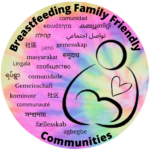A lactation-friendly workplace is one that welcomes lactating employees and proudly supports their infant feeding goals by providing time and private space to express milk—recognizing that meeting human biological needs lowers healthcare costs and improves retention, and also fosters a healthier, more respectful, and more productive work environment.
When an organization commits to being “breastfeeding friendly,” it is making a promise: to create an environment where lactating families are welcomed and respected. At Breastfeeding Family Friendly Communities (BFFC), we define this promise through action, rooted in our Ten Steps to a Breastfeeding Family Friendly Community—a framework adapted from the World Health Organization (WHO)/UNICEF Baby-Friendly Hospital Initiative to apply across workplaces, businesses, schools, and municipalities.
A Clear Definition
At its core, a breastfeeding or lactation-friendly workplace is one where:
- Lactating employees are given time to express milk or nurse their children during the workday.
- Private, non-bathroom spaces are available for milk expression, equipped with an outlet and access to hand hygiene.
- Supervisors and colleagues understand the importance of lactation, and policies are communicated clearly so employees feel confident using them.
This is not just compliance—it’s an invitation. To be truly family-friendly, workplaces must go beyond the legal minimums of the PUMP Act and create a culture that values and normalizes human milk feeding.
Recognition Through Designation
At BFFC, we honor organizations through a tiered designation system that reflects their commitment:
- Community Partner Award: For local businesses and public-facing organizations that welcome and respect breastfeeding families in their spaces.
- Breastfeeding Friendly Employer Award: For workplaces that provide adequate breaks, private lactation spaces, and written support policies.
- Breastfeeding Family Friendly Community Designation: For municipalities and institutions that implement all Ten Steps systemically, embedding breastfeeding support across policies, services, and culture.
Each award is grounded in action steps and inclusion—ensuring that breastfeeding, chestfeeding, and human milk feeding families of all backgrounds are fully supported.
Why This Matters
Research shows that breastfeeding-friendly workplaces and schools benefit everyone:
- Families experience lower stress, improved health outcomes, and longer breastfeeding duration.
- Employers see a 3-to-1 return on investment through reduced absenteeism, lower healthcare costs, higher productivity, and improved employee retention.
- Communities strengthen their public health infrastructure, advancing equity and resilience.
Moving Beyond Compliance
To be “breastfeeding friendly” is to recognize that supporting human milk feeding is a matter of equity, health, and human rights. Posting a welcoming sign, writing and sharing a clear policy, and applying for local or state designations are all ways that organizations can demonstrate leadership.
Being family-friendly means building systems where parents don’t have to choose between nourishing their child and pursuing their career or education. That’s the standard we invite every workplace and institution to adopt.
